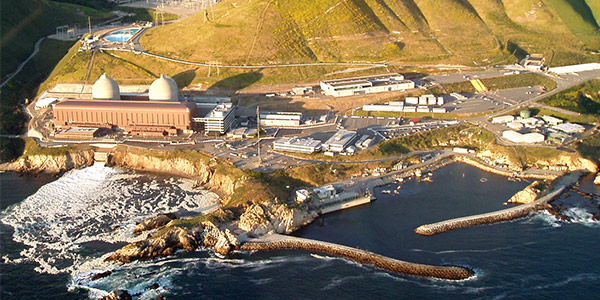NERC last week urged FERC to reject a request filed by the nonprofit group Californians for Green Nuclear Power (CGNP) in October to overturn the planned closing of Pacific Gas and Electric’s Diablo Canyon Power Plant, California’s last nuclear generating station, in 2025 (EL21-13).
CGNP describes itself as a collection of “dedicated scientists … with decades of experience [in] power generation, grid safety and emissions reduction” that is “dedicated to promoting the peaceful use of safe, carbon-free nuclear power.” Its complaint alleges that the closure of Diablo Canyon will cause “adverse bulk electric system and … bulk natural gas system consequences” that NERC and WECC, along with CAISO, the California Public Utilities Commission, the California State Lands Commission and the State Water Resources Control Board have failed to properly anticipate or counter.
Shutdown Planned by PG&E, Green Groups
Diablo Canyon consists of two nuclear reactors with a nameplate capacity of 2.3 GW and has operated since 1985. In 2019, it produced nearly 16.2 TWh of electricity, according to the U.S. Energy Information Administration, accounting for about 10% of in-state generation.
PG&E asked the CPUC in 2016 to approve a plan to shut the plant down in phases beginning in 2024, with full closure the following year. Under the proposal, created in partnership with environmental, labor and anti-nuclear advocacy groups, Diablo Canyon will be replaced with “a portfolio of [greenhouse gas]-free resources.” The utility described this plan as “the most effective and efficient path forward” for meeting renewable energy goals set by California’s legislature in 2015.
CGNP has been a vocal critic of the shutdown plan since its inception, arguing before the CPUC that Diablo Canyon is the most cost-effective option for supplying the state’s power needs while also limiting carbon emissions. The group is far from alone in this concern; CAISO Vice President Mark Rothleder warned the ISO’s board last year that expected summer energy shortages could worsen when the plant is shut down. (See CAISO, CPUC Warn of ‘Reliability Emergency’.)
CGNP also warned that retiring the plant will create strains on the BES because California will need to import more natural gas to make up the difference, and natural gas imports rely on an “aging and vulnerable” transmission and storage system. Trying to replace Diablo Canyon’s generation capacity with wind and solar facilities is problematic because of their reliance on transient resources, as opposed to nuclear fuel with an assured supply, it said.
“Rather than serving as an isolated incident, the August 2020 blackouts point to much larger systemic reliability challenges that will only be made worse by the voluntary closure of” the plant, the organization said in its complaint. “There are present reliability challenges to the California natural gas bulk transmission and storage system that are a consequence of its vulnerability to sudden earthquake motions and slow aseismic (without an earthquake) creep caused by the relative motion of Earth’s crustal plates.”
Respondents Critique ‘Unclear’ Legal Basis
CGNP’s filing drew some support from activist groups, including the Thorium Energy Alliance (TEA), which advocates “preserving and expanding the fleet of domestic [U.S.] nuclear reactors,” and the American Nuclear Society, a professional organization of nuclear engineers and scientists. Both groups echoed the organization’s warnings of rolling blackouts and “further weakening California’s power grid,” and TEA further argued that shutting down the state’s last nuclear plant would hamper its nuclear education industry.
In response, NERC and the other respondents took issue with a number of elements in CGNP’s filing. Most significantly for the ERO, the complaint cites no specific violations of reliability standards, instead offering “general, nonspecific assertions” about NERC and WECC failing to conduct proper oversight. Moreover, licensing nuclear power plants does not fall under the authority of the ERO; “as such, it is difficult to even infer the types of reliability standards violations the complaint is trying to allege,” NERC notes.
PG&E made a similar assessment in a separate filing, asserting that “responsibility for electric generation resource planning in California rests with state authorities” rather than with FERC. Other respondents, including the CPUC and CAISO, echoed this argument, calling the legal basis for CGNP’s complaint “unclear.” For example, CAISO pointed out that CGNP accused it of violating the Natural Gas Act of 1938 and the Federal Pipeline Safety Regulations, which do not apply to it as an ISO.
“CGNP’s complaint fails to meet the requirements of the commission’s Rule 206, is inconsistent with the Federal Power Act and makes factual errors,” the CPUC said. “CGNP’s complaint against the CPUC therefore has no merit and should be rejected in an order based on the pleadings.”




